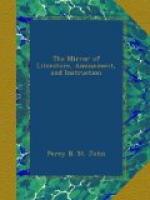It came from mine
own heart, so to my head,
And thence into
my fingers trickled:
Then to my pen,
from whence immediately
On paper I did
dribble it daintily.’—p. lxxxix.”
Mr. Southey has carefully examined this charge of supposed imitation, in which so much rests upon the very simplicity of the conception of the story, and has successfully shown that the tinker of Elstow could not have profited by one or two allegories in the French and Flemish languages—works which he could have had hardly a chance to meet with; which, if thrown in his way, he could not have read; and, finally, which, if he had read them, could scarcely have supplied him with a single hint. Mr. Southey, however, has not mentioned a work in English, of Bunyan’s own time, and from which, certainly, the general notion of his allegory might have been taken. The work we allude to is now before us, entitled, ’The Parable of the Pilgrim, written to a friend by Symon Patrick, D.D., Dean of Peterborough;’ the same learned person, well known by his theological writings, and successively Bishop of Chichester and Ely. This worthy man’s inscription is dated the 14th of December, 1672; and Mr. Southey’s widest conjecture will hardly allow an earlier date for Bunyan’s Pilgrim’s Progress, 1672 being the very year in which he was enlarged from prison. The language of Dr. Patrick, in addressing his friend, excludes the possibility of his having borrowed from John Bunyan’s celebrated work. He apologizes for sending to his acquaintance one in the old fashioned dress of a pilgrim; and says he found among the works of a late writer, Baker’s Sancta Sophia, a short discourse, under the name of a Parable of a Pilgrim; ’which was so agreeable to the portion of fancy he was endowed with, that he presently thought that a work of this nature would be very grateful to his friends also. It appears that the Parable of a Pilgrim, so sketched by Dr. Patrick, remained for some years in the possession of the private friend for whom it was drawn up, until, it being supposed by others that the work might be of general utility, it was at length published in 1678.—Before that year the first edition of the Pilgrim’s Progress had unquestionably made its appearance; but we equally acquit the Dean of Peterborough and the tinker of Elstow from copying a thought or idea from each other. If Dr. Patrick had seen the Pilgrim’s Progress he would, probably, in the pride of academic learning, have scorned to adopt it as a model; but, at all events, as a man of worth, he would never have denied the obligation if he had incurred one. John Bunyan, on his part, would in all likelihood have scorned, ‘with his very heels,’ to borrow anything from a dean; and we are satisfied that he would have cut his hand off rather than written the introductory verses we have quoted, had not his Pilgrim been entirely his own.




